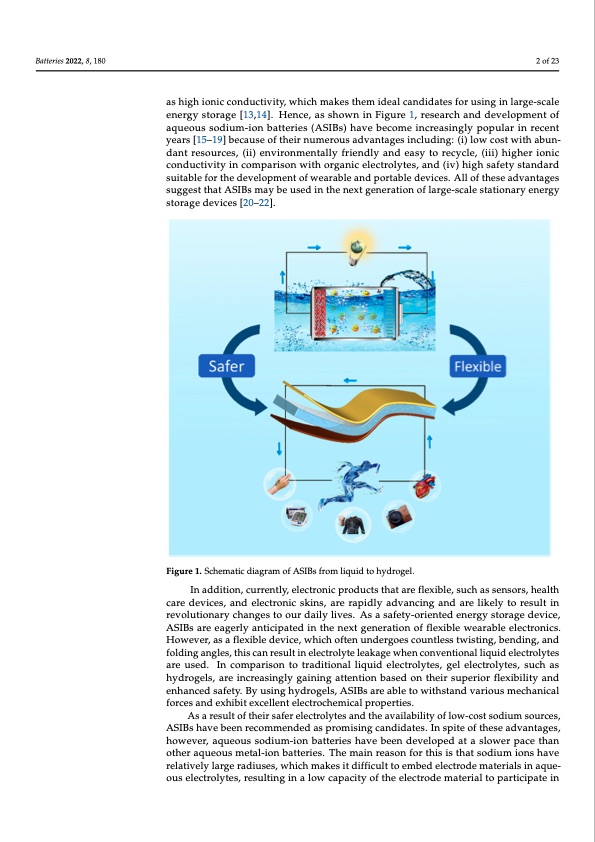
PDF Publication Title:
Text from PDF Page: 002
Batteries 2022, 8, 180 2 of 23 as high ionic conductivity, which makes them ideal candidates for using in large-scale energy storage [13,14]. Hence, as shown in Figure 1, research and development of aqueous sodium-ion batteries (ASIBs) have become increasingly popular in recent years [15–19] because of their numerous advantages including: (i) low cost with abun- dant resources, (ii) environmentally friendly and easy to recycle, (iii) higher ionic conductivity in comparison with organic electrolytes, and (iv) high safety standard eries 2022, 8, x FOR PEER REVIEW suitable for the development of wearable and portable devices. All of these advantages suggest that ASIBs may be used in the next generation of large-scale stationary energy storage devices [20–22]. Figure 1. Schematic diagram of ASIBs from liquid to hydrogel. Figure 1. Schematic diagram of ASIBs from liquid to hydrogel. In addition, currently, electronic products that are flexible, such as sensors, health care devices, and electronic skins, are rapidly advancing and are likely to result in 2. Electrolytes in ASIBs revolutionary changes to our daily lives. As a safety-oriented energy storage device, ASIBs are eagerly anticipated in the next generation of flexible wearable electronics. 2.1. Liquid Electrolyte However, as a flexible device, which often undergoes countless twisting, bending, and folding angles, this can result in electrolyte leakage when conventional liquid electrolytes There are numerous disadvantages associated with convention are used. In comparison to traditional liquid electrolytes, gel electrolytes, such as lytes, including their flammability, poor conductivity, and high cost. A hydrogels, are increasingly gaining attention based on their superior flexibility and enhanced safety. By using hydrogels, ASIBs are able to withstand various mechanical disadvantages, aqueous sodium-ion batteries with an aqueous electrol forces and exhibit excellent electrochemical properties. as an attractive option for large-scale energy storage. The problem w As a result of their safer electrolytes and the availability of low-cost sodium sources, ASIBs have been recommended as promising candidates. In spite of these advantages, is the low operating voltage required to prevent water from decomp however, aqueous sodium-ion batteries have been developed at a slower pace than chemical reactions. In the electrolyte, water has an electrolytic pote other aqueous metal-ion batteries. The main reason for this is that sodium ions have relatively large radiuses, which makes it difficult to embed electrode materials in aque- trodes should have redox potentials between the hydrogen and oxy ous electrolytes, resulting in a low capacity of the electrode material to participate in in order to prevent water electrolysis, which limits the operating volta in a lower energy density for ASIBs compared to organic sodium-ion a considerable amount of research is focused on increasing the operat electrolyte in order to develop a high-performance ASIBs. a y i o n g g b iPDF Image | Aqueous Rechargeable Sodium-Ion Batteries Hydrogel

PDF Search Title:
Aqueous Rechargeable Sodium-Ion Batteries HydrogelOriginal File Name Searched:
batteries-08-00180-v2.pdfDIY PDF Search: Google It | Yahoo | Bing
Salgenx Redox Flow Battery Technology: Salt water flow battery technology with low cost and great energy density that can be used for power storage and thermal storage. Let us de-risk your production using our license. Our aqueous flow battery is less cost than Tesla Megapack and available faster. Redox flow battery. No membrane needed like with Vanadium, or Bromine. Salgenx flow battery
| CONTACT TEL: 608-238-6001 Email: greg@salgenx.com | RSS | AMP |